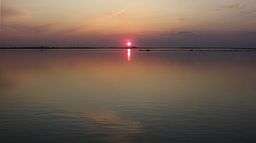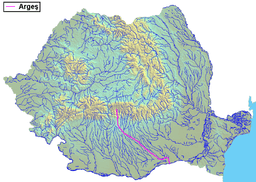Argeș (river)
| Argeș | |
 The Argeș in Mihăilești-Cornetu | |
| Countries | Romania |
|---|---|
| Counties | Argeș, Dâmbovița, Ilfov, Giurgiu, Călărași |
| Tributaries | |
| - left | Buda, Râul Doamnei, Dâmbovița |
| - right | Neajlov |
| Cities | Curtea de Argeș, Pitești, Oltenița |
| Source | Făgăraș Mountains |
| - elevation | 2,030 m (6,660 ft) |
| Mouth | Danube |
| - location | Oltenița |
| - coordinates | 44°3′33″N 26°37′1″E / 44.05917°N 26.61694°ECoordinates: 44°3′33″N 26°37′1″E / 44.05917°N 26.61694°E |
| Length | 350 km (217 mi) |
| Basin | 12,550 km2 (4,846 sq mi) |
| Discharge | |
| - average | 73 m3/s (2,578 cu ft/s) |
| Progression | Danube→ Black Sea |
 The Argeș in Romania
| |
The Argeș (Romanian pronunciation: [ˈard͡ʒeʃ]) is a river in Southern Romania. It is 350 km (220 mi) long, and its basin area is 12,550 km2 (4,850 sq mi).[1] Its source is in the Făgăraș Mountains, in the Southern Carpathians and it flows into the Danube at Oltenița.
The main city on the Argeș is Pitești. Upstream, it is retained by the Vidraru Dam, which has created Lake Vidraru. Its upper course, upstream of Lake Vidraru, is also called Capra.
Name
The river is believed to be the same as Ὀρδησσός Ordessus, a name mentioned by Ancient Greek historian Herodotus.[2] The etymology of Argeș is not clear. Traditionally, it was considered that it's derived from the ancient name, through a reconstructed term, *Argessis. The capital of Dacian leader Burebista was named Argedava, but it appears that it has no link with the name for the river.[3]
An alternate etymology derives the name of the river from a Pecheneg word, transliterated into Romanian as argiș (meaning "higher ground"). The earliest recorded variants of the name, referring to the city of Curtea de Argeș (lit. "The Court on the Argeș"), also suggest a derivation from this word: Argyas (1369), Argies (1379), Arghiș (1427), the river probably taking the name of the city.[3]
Localities
The following localities are situated along the river Argeș, from source to mouth: Căpățânenii Ungureni, Căpățânenii Pământeni, Arefu, Poienarii de Argeș, Corbeni, Rotunda, Albeștii de Argeș, Curtea de Argeș, Băiculești, Merișani, Bascov, Pitești, Găești, Bolintin-Deal, Adunații-Copăceni, and Oltenița.
Hydro energy
The Argeș River and some of its tributaries are used for hydro energy.[4] The hydroelectrical system consists of several dams, lakes, tunnels and power plants.[5] The lakes built on the Argeș River are: Vidraru, Oiești, Cerbureni, Curtea de Argeș, Zigoneni, Merișani, Budeasa, Bascov, Pitești, Călinești (or Golești), Zăvoiu (near Mătăsaru), Ogrezeni and Mihăilești.[6] There are dams also on its tributaries.
Tributaries
Argeș has for its left tributaries: Braia, Mândra, Buda, Valea cu Pești, Valea Lupului, Limpedea, Chiciura, Valea Iașului, Vâlsan, Râul Doamnei, Râncăciov, Cârcinov, Budișteanca, Sabar, Dâmbovița, Rasa, and Luica.
Its tributaries on the right are Paltinul, Lespezi, Modrugazu, Cumpăna, Valea lui Stan, Arefu, Bănești, Valea Danului, Tutana, Schiau, Bascov and Neajlov.
See also
References
- ↑ Danube River Basin District, Part A - Roof Report, IPCDR, p 12
- ↑ George Ioan Brătianu, Une énigme et un miracle historique: le peuple roumain, Editura Științifică și Enciclopedică, Bucharest, 1989, p.138
- 1 2 Alexandru Madgearu, "Români și pecenegi în sudul Transilvaniei", in Zeno-Karl Pinter, Ioan-Marian Țiplic, Maria-Emilia Țiplic (eds.), Relații interetnice în Transilvania, Sec. VI-XIII, Editura Economică, Bucharest, p.117. ISBN 973-709-158-2.
- ↑ http://www.hidroelectrica.ro/Details.aspx?page=37
- ↑ "BAZINE HIDROGRAFICE ÎN ROMÂNIA" (PDF). Retrieved 20 September 2011.
- ↑ """" (PDF). Archived (PDF) from the original on 27 March 2012. Retrieved 20 September 2011.
Further reading
- Administrația Națională Apelor Române, Cadastrul Apelor, Bucharest
- Institutul de Meteorologie și Hidrologie, Rîurile României, Bucharest, 1971